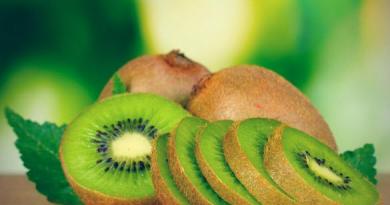Physalis is a typical representative of the widespread genus Physalia from the Solanaceae family. It grows naturally in Central and South America. At home, all physalis are perennial herbaceous plants. All of them have a common distinguishing feature - a fruit in the form of a berry, enclosed in a kind of lantern of sepals.
Of the ornamental species, the common physalis is most widely used in gardens. This flower is also known as "Chinese lanterns". This is a perennial herbaceous plant no more than 50-60 cm high with bright orange berries in a flower - a flashlight. They look quite impressive and therefore are very often used as dried flowers to make a winter bouquet. The flowering period of this species falls at the beginning of summer, and the ripening of fruits at the beginning of September. At this moment, the lanterns acquire their characteristic bright color.
Physalis Franchet is also grown as an ornamental species. Its height is about 90 cm. It is also a herbaceous perennial. It differs from the previous species in a large number of shoots, on which numerous and rather large bright orange lanterns are located. Against the background of the autumn gardens, its bushes look like a fire.
After staining the lanterns in September, its stems are cut and dried in the shade. Then they are used to compose various compositions and arrange winter bouquets. How much physalis branches will stand in a bouquet is affected by the degree of their maturation. The brighter the lanterns, the riper they are and, therefore, last longer.
How to sow physalis (video)
Edible species and varieties of physalis
The fruits of some species of physalis can be eaten. On the territory of Russia, the most widespread are the following types:
berry physalis
This group is distinguished by fruits of a rather modest size. The berries of these species, although small, are very fragrant, and they can taste like pineapple or strawberries.
Physalis strawberry (Peruvian)
An annual herbaceous plant with edible fruits. It is characterized by low bushes with lateral shoots spread in all directions. The flashlight of strawberry physalis is not bright and not large in size, but its berries are very fragrant and contain a large amount of vitamins and other useful substances.
The berries have a rich amber color and a pleasant sweet and sour taste with a strawberry flavor. They are quite widely used for culinary purposes. For example, they make excellent jam with a very original taste.
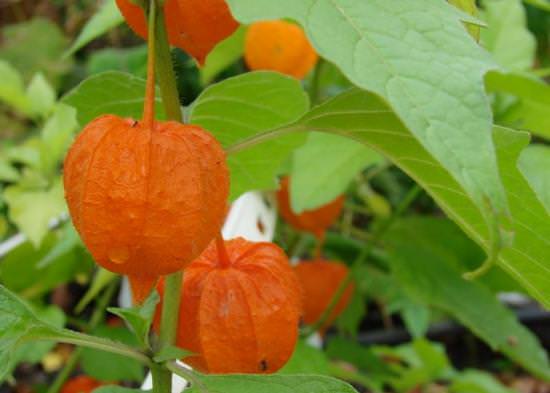
Physalis strawberry (Peruvian)
Physalis florida
Differs in sweet fruits without the slightest sourness. Its berries do not have any fruity flavor or aroma. Jam from its fruits in appearance resembles jam from yellow-fruited cherries. To improve the taste characteristics, it is desirable to flavor it with citrus peels.
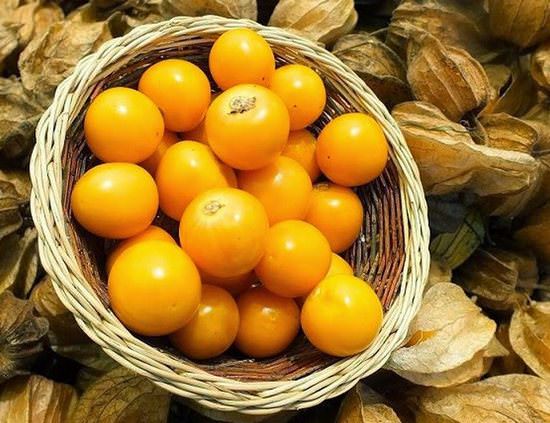
Physalis florida
Physalis pubescent (raisin)
It has a rather refined taste. Its berries are sweet with a slightly noticeable sourness, with a rich fruity aroma and pineapple taste. Physalis raisin juice is very similar to tangerine juice. Jam from its berries is a rich amber color. Also, the fruits of this species can be well stored. Subject to the conditions, they do not lose their properties for 3-4 months. From dried berries of this species, almost real raisins are obtained.
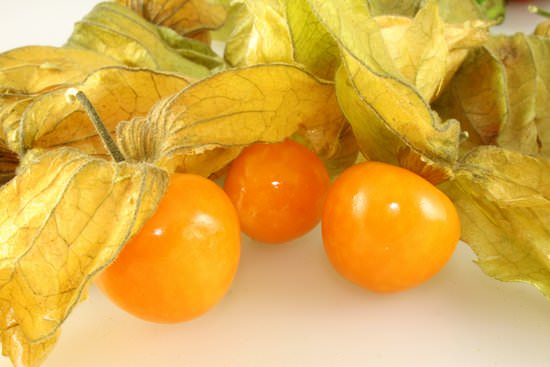
Physalis pubescent (raisin)
Physalis pineapple
separate botanical species. Unlike its strawberry cousin has smaller berries weighing about 10 g. Their taste is rich and very sweet. Berries of this species can be used for fresh consumption, candied and dried.
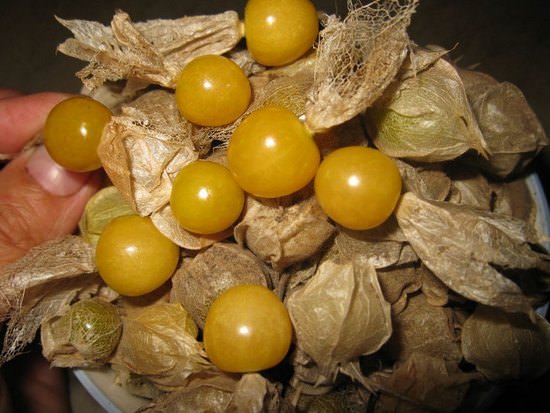
Physalis pineapple
vegetable physalis
The fruits of vegetable physalis are quite large. When they reach maturity, they turn yellow. Unlike fresh berry species, it is absolutely tasteless. Its main purpose is cooking vegetable stews and marinating. In pickled form, it tastes little different from tomatoes.
Ground Gribovsky
It is characterized by fruits of light green color with a specific sourness. The average weight of berries is about 50 grams. Plant height is up to 80 cm. Part of the shoots of this variety can spread along the soil surface.
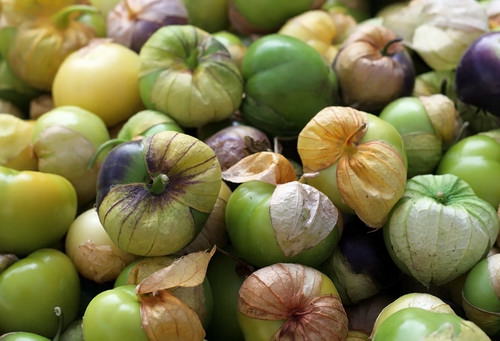
Physalis ground Gribovsky
Confectioner
Mid-late variety with light green fruits . The taste of its berries is closer to sour. Their weight is about 40 grams. Bushes tend to branch strongly.
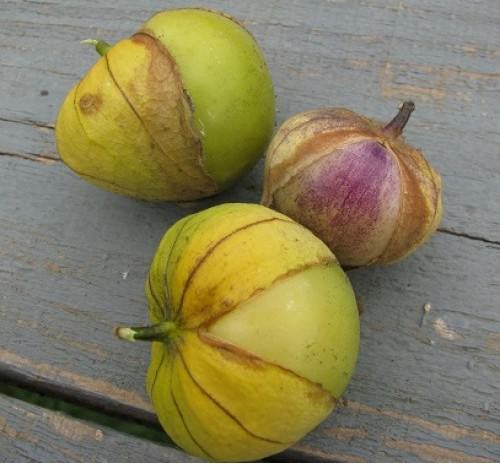
Physalis confectioner
Wren
Early maturing variety with creeping bushes. Average yields are about 5 kg from each bush. In the immature state, the fruits are light green, when ripe, their color changes to yellow. The average weight of berries is from 50 to 80 grams.
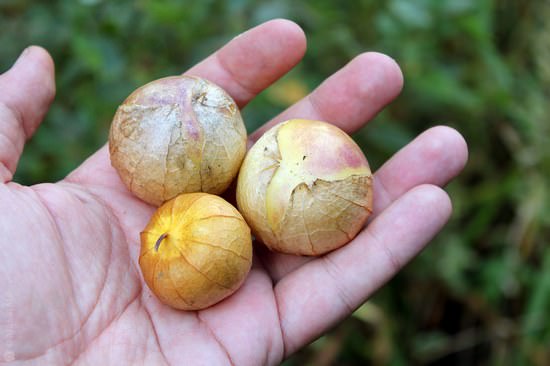
Physalis Kinglet
Features of growing physalis at home
You can grow physalis at home. To do this, you can use both perennial decorative species and early ripening berry varieties. To accommodate adult bushes, south-facing windows are best. . For the summer, plants can be taken out to the balcony, garden or loggia.
For wintering, physalis requires a temperature of at least 18 ° C. In summer, the plant is easily put up with the heat. The soil for growing suitable loose, nutritious with a slightly acidic reaction. Indoor physalis develops very well in universal soil for growing seedlings. P olive is required moderate. It is impossible to allow neither complete drying of the earthen coma, nor excessive moisture. Water is best used previously settled at room temperature.
Physalis fruits can form without pollination. Just in this case, they will not contain viable seeds. When growing in a room, the plant needs to establish a support.
Varieties of Physalis (video)
Planting a plant with Chinese lanterns in open ground
For outdoor cultivation, Physalis Franchet is best suited. It is able to easily endure 30 ° frosts and therefore can be grown even in the Urals. In addition, it is absolutely undemanding to the soil. Depending on the variety, this species can be either tall, with the height of the plants reaching 1 meter, or a rather miniature plant with a bush height of about 35 cm.
For planting, it is best to choose a place well-lit by the sun with fairly fertile soil. Subject to this condition, the physalis lanterns will be the largest and brightest. It is not required to form this plant. And to keep its branches straight, for example, if you plan to use it for winter bouquets, the plant can be tied up.
Subsequent care for physalis consists of periodic watering, loosening the soil and removing weeds. In dry summers, it is advisable to water the plant about 3 times a week.. To speed up the coloring of lanterns on a bush at the end of summer, the tops of large shoots are pinched. Once every 6-7 years, overgrown rhizomes are recommended to be divided and transplanted to a new place.

For planting physalis, it is best to choose a place well-lit by the sun with fairly fertile soil.
Features of caring for physalis in the country
All types of physalis have a fairly long growing season. That is why they recommended to grow through seedlings. The timing of its landing in open ground depends on the climatic conditions of each particular region. In most cases, this is the second half of May. Immediately after planting, the seedlings should be shaded with a non-woven covering material. This will help her to adapt more easily to the new place.
Further care for physalis consists in removing weeds, loosening the soil surface and regular watering. Also, the bushes of this culture must be properly formed. To do this, all side shoots located under the first flower brush are plucked.
The watering regimen for physalis is approximately the same as for tomatoes. Until the end of July, frequent and plentiful. It is best to water the plants in the evening under the root.. Since August, watering is stopped. If after this the plants continue to grow, they pinch the tops. When the lanterns look yellow and the berries inside turn orange, this indicates the onset of ripeness. From this moment you can start harvesting.
Physalis pods are rather difficult to separate from the bush. So to facilitate the process, you can use a knife or secateurs. Immediately after collection, they are laid out for further drying in a dry and cool place. Under all conditions, physalis fruits can be stored for several months without losing their quality characteristics.

In dry summers, it is advisable to water the physalis about 3 times a week.
Plant propagation methods
All types of physalis can be grown from seed. To do this, in the second half of March, they begin to sow them in seedlings. As a soil, a universal substrate is used for growing seedlings of vegetable crops.
The seeding depth should not exceed 0.5 cm. Physalis shoots appear quickly enough. Usually the first sprouts appear on the 5-6th day. Caring for them consists in timely watering and loosening the soil.
After the appearance of the first true leaf of the plant, you can pick into larger containers. The optimal age of seedlings at the time of planting should be about 55-60 days. You can plant physalis seeds immediately and in open ground. But in this case, the yield will be lower. This method is most often used in the southern regions.
Reproduction of perennial species of physalis is also possible by dividing the rhizomes. Spend it in the autumn or spring. To do this, with the help of a shovel or a sharp knife, they are cut into separate sections. Each of them must have a sufficient number of viable kidneys. They should be planted in a new place at a distance of at least 0.5 meters from each other.
Flowers such as physalis can also be propagated by cuttings. To do this, green cuttings are cut from the plant, which are then planted in a cuttings for further rooting.
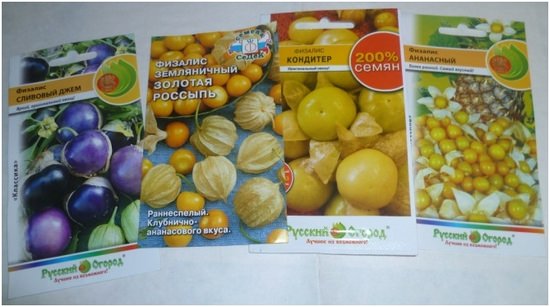
All types of physalis can be grown from seeds
Physalis in cooking
The use of physalis in cooking is quite diverse. Fruits of strawberry physalis with dessert taste are especially appreciated. They are often used to make various jams. There are even special jam varieties of this culture. They have a high content of pectin. This berry can also be used as an additive to the main fruit filling, such as pear or apple.
For culinary purposes, both ripe and unripe physalis berries can be used. Just before that, they must be washed off with a special adhesive substance. Especially a lot of it on vegetable varieties of this crop. Berry physalis can be consumed fresh. It is also quite tasty in candied or pickled form. If they are dried, then in terms of their taste they are practically not inferior to raisins. Due to the wide variety of taste shades of physalis, everyone can choose the variety that suits him. You can even cook side dishes and vegetable stews from vegetable varieties. They are also delicious marinated. They can also be cooked in a variety of ways: stew, fry or bake in the oven. Vegetable physalis is added to sauerkraut, pickled tomatoes or cucumbers.


